With May 2017 as the deadline to electrify all “18,475 powerless villages” of the country, and the promise of light this Diwali, the Centre, Uttar Pradesh government and the UP BJP have hit the road in the state. Ishita Mishra trails one such team to find what it takes to fix a light bulb. Photographs: Amit Shivhare
THOUSAND days or May 2017 is the deadline announced by Prime Minister Narendra Modi to completely electrify the powerless “18,475 villages” of the country. This Independence Day, he referred to Nagla Fatela in Hathras, Uttar Pradesh, as one of the villages his government had been able to get power to. Since it turned out that Nagla Fatela wasn’t fully electrified, officials have hit the field to verify claims regarding the other 1,449 ‘virgin (or completely power-less)’ villages declared electrified by Uttar Pradesh since 2013-14.
The Union Power Ministry’s rural electrification engineers, called ‘Gram Vidyut Abhiyantas’, are out in the villages to check, while the state’s Dakshinanchal Vidyut Vitran Nigam Limited (DVVNL) is verifying door to door. BJP state president Keshav Prasad Maurya is also on the job, to check whether the power infrastructure and supply are in line with the information available with the Centre. He says his visits have shown that “the Uttar Pradesh government is against development… It is unable to use the funds allocated by the Centre”.
The Sunday Express followed one team of DVVNL led by Managing Director Satyaveer Singh Rathore as it did the rounds of Etah, Aligarh and Kasganj districts for a power check. In the 21-odd UP districts under it, DVVNL claims to have electrified more than 95 per cent of the villages.
But everywhere, falling somewhere between a power connection and electricity supply, there is a Nagla Fatela.
Nagla Ranjeet Village, Etah

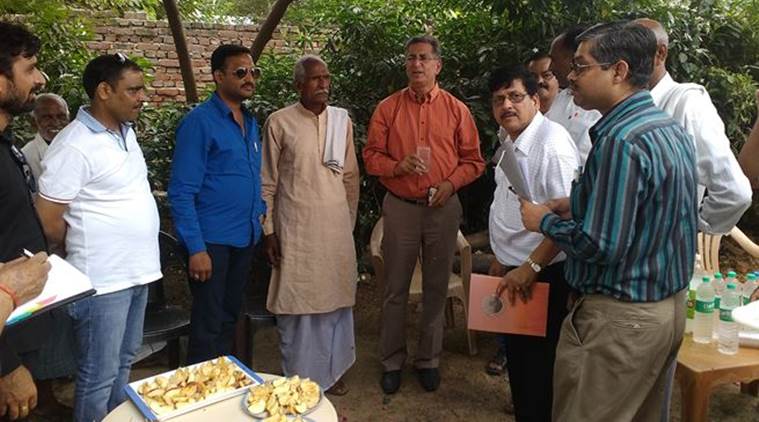 The convoy is accompanied by former zila panchyat member Sunil Singh Rathore, whose presence with the officials is dutifully noted by the villagers.
The convoy is accompanied by former zila panchyat member Sunil Singh Rathore, whose presence with the officials is dutifully noted by the villagers.
Population: Around 700
Households: 120-130
Houses with power connection: 25-30
Power status: Electrification work on the verge of completion
Bidhnu Ram, 55, is surprised at the sight of 10-12 SUVs driving into the village. This happens only during elections, he remarks, “ye to bin mausam aa gaye (they have come without any reason)”. Gram Pradhan Brajmohan Kumar, who has been busy making preparations to receive the “bijli-wale babus”, interrupts him with a knuckle on the head: “These are power officials. Don’t you want electricity?” The convoy is accompanied by former zila panchyat member Sunil Singh Rathore, whose presence with the officials is dutifully noted by the villagers.
A crowd soon gathers around MD Rathore. When he asks the villagers if they have power, he is stunned to hear their unanimous “no”. DVVNL had sub-contracted Shilpa Engineering (Hyderabad), a private firm, to finish the electrification work at Nagla Ranjeet, including putting up the poles, laying the cable lines and placing the junction boxes. Two officials of the company are part of the convoy, and as Rathore glares at them, they speak in a rush, “We have ordered junction boxes. We will place them on the poles very soon. Other work is done.”
DVVNL Etah chief A K Jain nods his head, but Rathore isn’t convinced. “Your work is to provide full infrastructure. How can you share a final report with us till the village is electrified?” he says, ordering that the junction boxes be installed in the next three days.
The officials of the private firm protest that the time is too little, as they need to put up almost 60 junction boxes. Rathore ignores them, turning to the crowd to ask, “Are all of you ready to take connections?” At this, the villagers who have been following the team disperse.
Rathore, who has seen this before, laughs. How many houses have power connections here, he asks Jain. With the electrification process stuck, they only have connections so far, and not supply. Jain replies 25-30, including both APL and BPL families. There are 40 BPL houses in Nagla Ranjeet, says DVVNL officials. The government is laying stress on BPL families, which are being given connections free of cost.
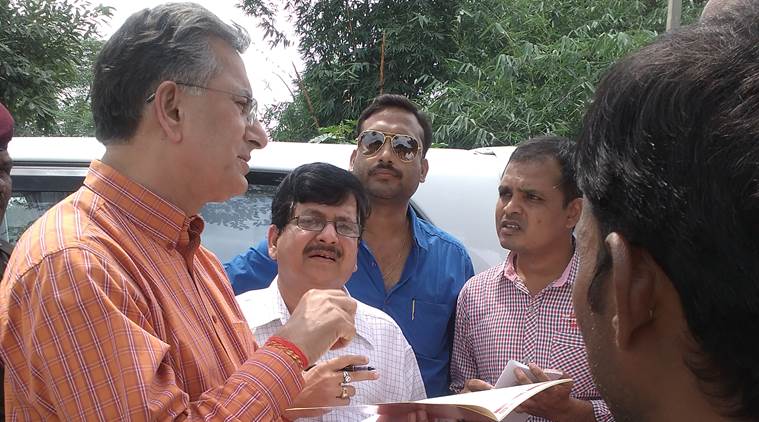 A crowd soon gathers around MD Rathore. When he asks the villagers if they have power, he is stunned to hear their unanimous “no”.
A crowd soon gathers around MD Rathore. When he asks the villagers if they have power, he is stunned to hear their unanimous “no”.
“This is what happens regularly,” Rathore tells the local politicians and officials with him. “The GARV app of the Central government doesn’t consider a village electrified unless 10 per cent of its households have power. In villages, even this is impossible.”
Villagers are too poor to pay power bills, officials explain. Or too reluctant, as they can manage power via illegal katia connections, tapping power from transformers provided by the state government to run tubewells.
“Why get a connection when they can simply steal power?” comments a DVVNL official, before he is hushed by Rathore. Besides, other officials point out, the current scheme doesn’t take into account consumers not paying up or fix responsibility for conducting repairs should power lines collapse.
“We actually cannot afford power bills,” argues Ramesh Kushwaha. “We already pay for tubewells, another bill is a burden for a farmer who earns Rs 5,000-6,000 a month.” Uttar Pradesh Power Corporation Limited (UPPCL) — DVVNL comes under it — currently has around Rs 28,000 crore of unpaid bills, apart from Rs 7,000-8,000 crore of pending bills under litigation.
The average charge for domestic power use in UP is Rs 4 per unit, with rates differing for agriculture, commercial and industrial usage. In villages, due to unmetered power supply, the power tariff is fixed at between Rs 320 and Rs 375 for two months. The tariff was increased last year.
Narauri village, Etah
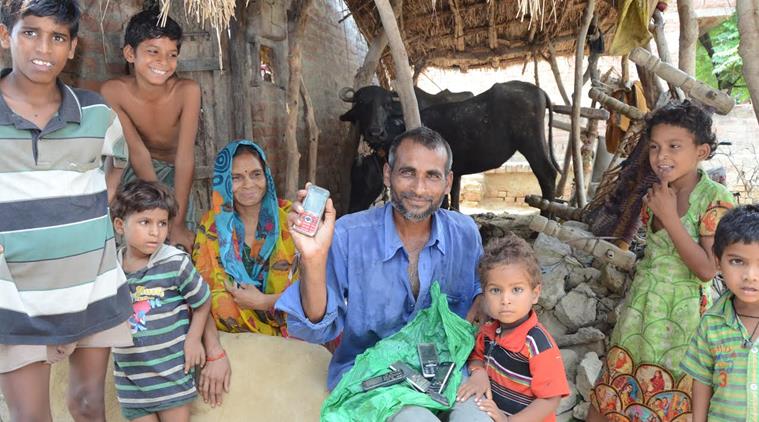 Mahendra, with his wife and kids, shows mobile phones that he is fond of collecting but can’t charge.
Mahendra, with his wife and kids, shows mobile phones that he is fond of collecting but can’t charge.
Population: 6,000
Households: 1,500
Houses with power connection: Around 90
Power status: Certified ‘electrified’ in 2014, village hasn’t yet been connected to main power line due to technical glitches. It is now being ‘re-electrified’
Villagers here are ready for the visiting team and surround the DVVNL officials as soon as their convoy drives in.
“Sir, I don’t have power but now have this bill of Rs 12,000. Gharau bech dei to bhi na chuka pai (I can’t pay this even if I sell my house),” pleads 48-year-old Mahendra Singh. Rathore hands the bill to his associate to check. The bill says the consumer used 1,700 units of power between 2000 and 2002, and the amount includes the interest due. However, the village is being re-electrified only now.
When the MD asks the villagers if they get power, the answer is no. “All of you will get electricity soon. The BPL families will get free connections. So do not pay a single paisa to any Power Department official. We will also provide you an LED bulb free,” he says. The others will have to pay, Rathore clarifies. “They have to deposit Rs 1,830 for connection and meter-fitting. We will organise a camp soon.”
A middle-aged man raises his hand. “I am a BPL. So will I get free electricity?” he asks. No, no Jain laughs. “Nobody will get free power, only free connection. Everyone has to pay the power bill.” The villagers are shocked. The government promised power but never said they would have to pay for it, they say. The village has around 117 BPL households. “Tab kaun lega bijli (Who will take a connection then)?” argues Shravan Kumar, adding that they could just continue with katia power.
UP has almost 52,12,392 BPL households (as per the 2011 Census). Just 15,39,383 (around 30 per cent) have taken power connections till now. The total number of katia connections is estimated to be around 30 lakh. UPPCL officials say these amount to a total annual loss of more than Rs 8 crore.
Dhunnaiya village, Etah
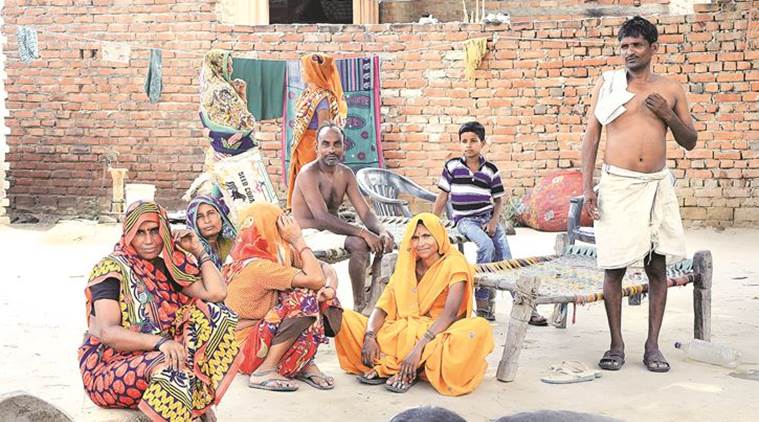 At ‘unelectrified’ Dhunnaiya village. One of the stories the village is fond of recounting is that of Pradeep Kumar, the 30-year-old who burnt all the electronic goods his wife had got for dowry, as they were of no use without electricity.
At ‘unelectrified’ Dhunnaiya village. One of the stories the village is fond of recounting is that of Pradeep Kumar, the 30-year-old who burnt all the electronic goods his wife had got for dowry, as they were of no use without electricity.
Population: Around 750
Households: 160 Houses with power connection: None (though meters were placed in around 6 houses decades ago)
Power status: Un-electrified
Dhunnaiya is known in these parts for what one of its angry residents, 30-year-old Pradeep Kumar, did one day.
Sometime in 2015, while his wife Sangeeta was away at her parents’ home, he set a TV, a mixer-grinder and some other electrical appliances he had got in dowry on fire. Sangeeta was furious, but admits she started talking to him again after a few days. “Rehna to aadmi ke saath hi hai naa ab (One has to live together after all),” she shrugs.
Pradeep’s mother Vidya Devi though doesn’t hold any grudges. “It is hard to keep one’s cool seeing other homes lit while yours is in the dark,” she justifies.
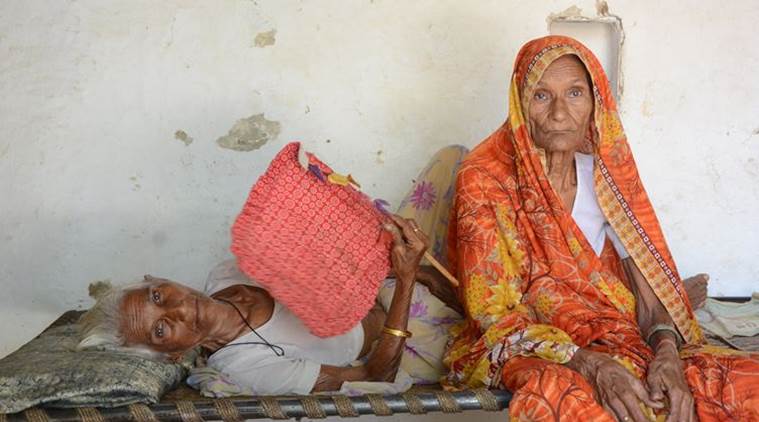 Bansidevi lying on cot with her sister Gangadevi.
Bansidevi lying on cot with her sister Gangadevi.
Unlike other villages, Dhunnaiya can’t rely even on katia connections from tubewells as fields are far away from the residential area. Vidya Devi is at the house of Bansi Devi, where all the women have gathered in the afternoon to talk as the men are away in the fields. Fanning her visiting sister Ganga Devi, lying on a cot, Bansi Devi rejects the suggestion of a Power Department official that she could be lying about not having a katia connection. “Go, go, check inside. Can you see a bulb or fan?” she shouts.
In fact, officials don’t find bulbs, fans or any electrical appliances in any of the houses in Dhunnaiya. Vimla Devi, who is among the group of women, says she has asked her younger daughter-in-law’s parents to give cash rather than any electronic equipment for dowry. She complains to officials about having received a power bill of Rs 12,000 last winter despite the lack of power. Officials say the bills would be corrected once the village is electrified.
 A dish Tv set-up placed on the top of a house in Dhunnaiya.
A dish Tv set-up placed on the top of a house in Dhunnaiya.
“We are all set to start electrification work in Dhunnaiya. Approvals are in place. The village will get power by the end of November,” promises Rathore. Life in Dhunnaiya is perhaps most difficult for Akanksha, 20, the daughter of Ashok Kumar, a primary teacher in Bahraich. Akanksha did her schooling from DPS in Delhi. Pointing to bulbs, a fan, fridge, computer, even a washing machine at their home, mother Sandhya says they have everything but power.
Most of the households have put up solar panels, on which they run one or two LED bulbs, one 12W fan, and a socket to charge a mobile phone.
Otherwise, like those in other power-less villages, they head out to shops to charge their cellphones and other such equipment. The shops near Golakua Chauraha in Dhunnaiya take Rs 10 to 30 to charge a phone. “Kaam chal jaata hai (We manage),” says Aakash. According to the GARV app, of the 97,813 inhabited villages in UP as per the 2011 Census, just 224 were ‘virgin (or completely powerless)’ on March 31, 2016. Till August 31, the app said, 131 of these had been “electrified”.
Jamalpur village, Etah
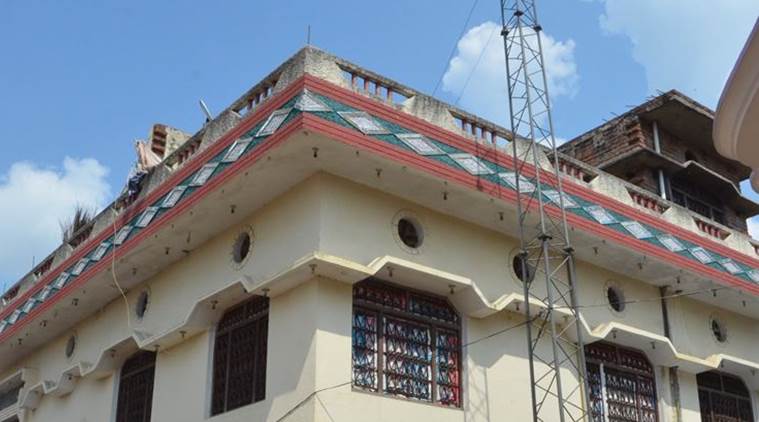 Jamalpur pradhan Bhanu Singh’s three-storey house (left) has 75 bulbs, yet he pays a fixed fill of Rs 375 for two months.
Jamalpur pradhan Bhanu Singh’s three-storey house (left) has 75 bulbs, yet he pays a fixed fill of Rs 375 for two months.
Population: 1,500
Households: 250
Houses with power connection: 8-10 (including BPL)
Power status: Officially has power since 1990; ‘re-electrified’ recently
In Jamalpur, they all tell the story of Mahendra. He is married with five children and lives in a kuchcha two-room house with his three buffaloes. The family doesn’t own even a BPL card. Mahendra, villagers say, is obsessed with mobile phones. He buys defunct cellphones from villagers for Rs 50, Rs 100, and gets them repaired. But he can never charge them. “It’s a waste of money,” scoffs wife Seema. Sitting outside his house, Mahendra laughs.
Jamalpur falls in the category of “re-electrified” villages — where the existing infrastructure is upgraded. The village has officially had power since 1990.
“I bought a fridge, an iron and a cooler after the village was re-electrified a couple of months ago. But I can never drink chilled water as we get power just for a couple of hours a day. Sometimes, there is no power for days,” says Bijay Singh Rathore, 32. MD Rathore tells villagers not to lose heart, and take power connections. “The Chief Minister will soon announce supply for up to 14 hours in villages. This may happen in October-November.”
 Moharshree Devi (66) from Jamalpur who saw both generations in the village, the one with power and the one without power.
Moharshree Devi (66) from Jamalpur who saw both generations in the village, the one with power and the one without power.
As officers start their door-to-door inspection, Rathore halts at the sight of a running tap, with water flowing down a drain. He admonishes the villagers that water is filled into tanks using a motor. Threatening to cut supply, he says, “The pradhan has to keep running the motor to fill the tank.”
Piyush Verma 19, a polytechnic student in Mathura, says life in the city is different. “Here, sometimes we get seven-nine hours power and sometimes, there is no power for four-five days. Can this be called electrification?” Rajkumar, 60, has a thresher, two coolers, a fridge, seven bulbs, three fans, iron and a mixer-grinder. He is planning to visit the DVVNL office about his April bill of Rs 735. “It’s too much,” he complains.
UPPCL officials admit their computers have technical glitches, leading to bills being generated at random. Even in villages where meters were installed but power couldn’t be provided, computers generate bills as details of consumers are on the records.
Moharshree Devi, 66, has seen both — a life without electricity and with power. She doesn’t feel much of a difference, she laughs. “Shuru-shuru mein connection liya tha. Phir bill nahin bhara to kaat gaye woh log. Ab to diya hi jalaate hain (I had taken a connection. But then I didn’t pay the bill and they came and cut it. Now we use lamps again),” she says, adding that the family of 19 is not planning to get a new connection.
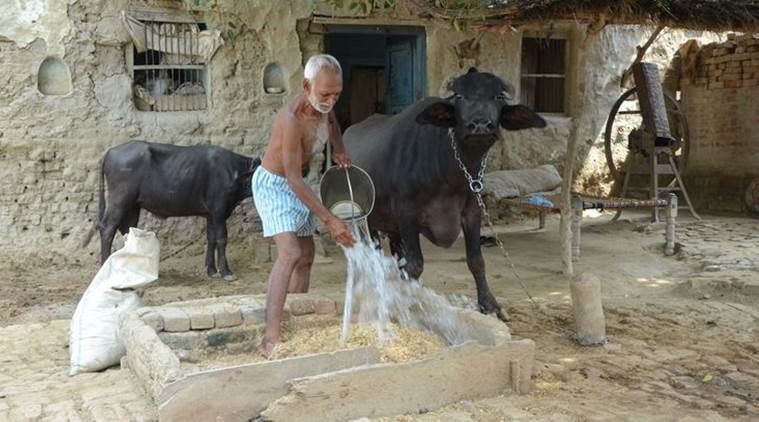 Rajkumar (60) from Jamalpur who has thrasher, two coolers, a fridge, seven bulbs, three fans, iron, mixer grinder in his house.
Rajkumar (60) from Jamalpur who has thrasher, two coolers, a fridge, seven bulbs, three fans, iron, mixer grinder in his house.
Jamalpur gram pradhan Bhanu Pratap Singh blames this on the katia connections. A B.Tech from Agra, he came back to the village to join politics. Irrespective of what Moharshee Devi says though, Singh says he is under great pressure as one village in his majra (a group of villages having the same pradhan), Jamalpur, has power while the other, Dhunnaiya, doesn’t. Pratap’s parents too were pradhans of Jamalpur, and his house is the biggest in the village, spread across three floors, with almost 15 rooms. The house has more than 75 bulbs, 25 on each floor. He pays Rs 375 for two months, as per the fixed bill.
“The power set-up in almost all the villages in UP is old. This is also the reason villagers are able to steal power so easily. Now we have decided to upgrade the existing structures. The new wires and cable lines are katia-resistant,” says Rathore. The Centre’s Deendayal Upadhyaya Gram Jyoti Yojana report shows that 1,07,181 villages in UP have to undergo ‘intensive electrification’ or ‘re-electrification’. But till August end, the state had only re-electrified 20,451 villages (19 per cent).
Nagla Bhoj village, Etah
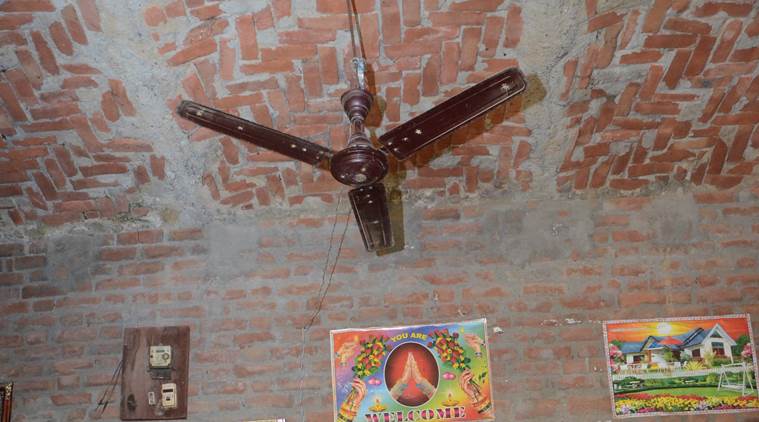 Electricity has remained a dream in this village.
Electricity has remained a dream in this village.
Population: 380-400
Households: 120
Houses with power connection: 70 (50% of them BPL)
Power status: Power came last year but too erratic due to faulty lines
Haripal Singh, 30, has not entirely removed the cardboard packing in which came his new, bright-red Whirlpool refrigerator, keeping it on the sides for “protection”. The only other object in his single-room, 11X8-ft hut is the bed.
The fridge cost Rs 12,000, says Singh, and he rushed to buy it as soon as his village got power last year. However, electricity has remained a dream, says Singh, opening the fridge door to show that it is empty.
“What can we do about the supply? That is managed in Lucknow,” a DVVNL official tells him. The official adds there is another problem ensuring continuous supply at a decent voltage. “We place small transformers as hardly a dozen villagers take connections. But most villagers use katia, and that overloads the transformers, which blow out.”
The official understands why private agencies are not interested in repair work. First, getting funds sanctioned is an issue, and by the time they receive the money, they have already incurred huge losses in putting up infrastructure, without enough people taking connections. The private companies get full payment only after a village is deemed electrified.
“That is what happened here. The set-up went kaput due to excess load as well as no connections. Some power lines were wrongly placed. Private agencies stopped working as they didn’t get funds. But we will make sure that power comes here before Diwali,” says Jain, the DVVNL Etah chief.
Still, Nagla Bhoj can hardly contain its excitement. With rains earning him a good harvest this year, Biru Kumar has his Diwali shopping list ready: a fan, a cooler, a tape-recorder, and a table lamp for his two daughters Radha and Pinky, who study in Classes IV and VI.
Around 70-80 private firms are involved in the electrification exercise in UP. DVVNL has contracted around 20 companies, through e-tendering. An official of Shilpa Engineering (Hyderabad), one such company working on electrification, says they didn’t anticipate the problems they would face. “We have worked in the south. We never faced such issues there. People here are just not ready to take connections,” he says, refusing to be identified.
Shailendra Dubey, chairman of the All India Power Engineers Federation, however, blames the private firms. He says the fact that these companies are not liable for anything is the basic problem with the village electrification drive in UP. “They just complete the work in a hurry and leave. Government employees have some liabilities towards the consumers and the government too.”
Dubey asks why UPPCL has so few employees, making it dependant on private firms. “When the state had 60 lakh consumers, one lakh employees were on its rolls. Now, when there are more than 1.75 crore consumers, UPPCL has just 30,000 people.”
Kheria Nagar Shah village, Etah
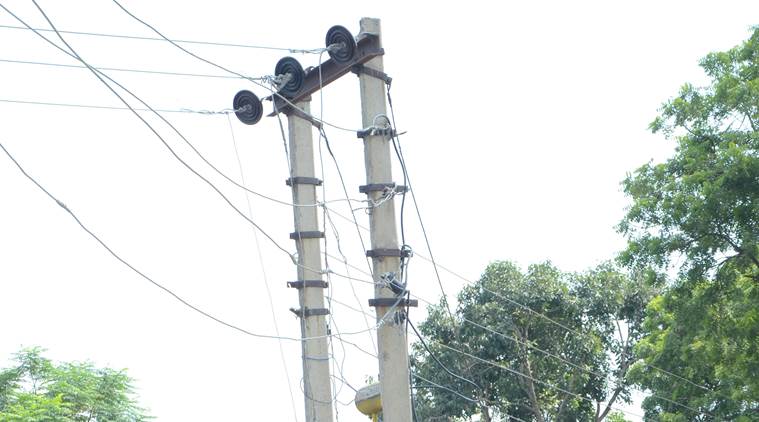 The 70-year-old wants the newly placed power pole outside his house shifted.
The 70-year-old wants the newly placed power pole outside his house shifted.
Population: 1,500
Households: 100-120
Houses with power connection: 15
Power status: Fully electrified village
The native village of MD Rathore, it is one of the most well-electrified villages in Etah, with even special wirings in place to check power theft. But villagers here are as bemused at the sight of the official convoy in their midst. At the Brahmin basti, Jamdaar Singh, a BPL, says he doesn’t have power but uses the connection taken by his brother, who lives nearby. “Dui-dui jagah bill kahe bhari (Why should we pay the bill at two places)? Anyway there is no power at night, and in daytime, we don’t need it.”
Rathore evades questions on whether there is uniform distribution of power between Dalit and upper caste homes. He picks a random Dalit house to check. The women inside tell him, “The officials came just a day before you arrived. We got power only yesterday.”
On paper, the village got power in 2010, but the set-up didn’t function properly. The MD leaves quickly, telling the villagers, “Chief Minister Akhilesh Yadavji has arranged power for all of you. You should take full benefit of this, get a connection.” But a DVVNL associate whispers in his colleague’s ear, “Kitna bhi Akhilesh Yadav kar lo, vote to ye sare Mayawati ko hi denge (Howsoever one may talk about Akhilesh, their votes will go to Mayawati).”
Mohd Ahesan has a different problem. The 70-year-old wants the newly placed power pole outside his house shifted. “Chirraiya phoot-phoot girat hai. Bakariya ko current maar gao. Ab janwaran ka ko batai ab gao ma bijli aa gai hai (The birds keep falling off wires dead. My goat got electrocuted. Who will explain to the animals that the village now has electricity)?”
Major electrification drives in UP
Jawaharlal Nehru National Solar Mission, Pradhan Mantri Gram Vidyut Yojna, Rajiv Gandhi Grameen Vidyutikaran Yojana, and Remote Village Electrification Programme. The NDA govt subsumed the Rajiv Gandhi Yojana under the Deendayal Upadhyaya Gram Jyoti Yojana (DDUGJY), launched in July 2015. Apart from electrification, the DDUGJY also sanctioned money for separation of feeders for domestic and agricultural usage; strengthening rural electricity distribution structure; metering of feeders, transformers and consumers. Most schemes are same, with some change in name, and upgradation in policies.
What is an electrified village?
Prior to October 1997, a village was classified as electrified if power was being used within its revenue area. Later, this changed to power being used in the inhabited locality, within the revenue boundary, for any purpose whatsoever.
Now a village is considered electrified if basic infrastructure such as distribution transformer and distribution lines are provided in the inhabited locality as well as the village’s Dalit basti; electricity has been provided to public places like schools, panchayat office, health centres, dispensaries, community centres etc; and if the number of households electrified is at least 10 per cent of the total households in the village.
Status of electrification in UP
As per the GARV App, the number of un-electrified villages in UP as of May 31 was 178; 46 villages had been electrified between April 1 and May 31. Almost all villages in UP have tubewells running on transformers provided by the state government.
How the scheme works?
Power is in the concurrent list, and the DDUGJY, just like previous schemes, banks on the Centre and state working together. The Centre provides money for infrastructure, and the state establishes it and supplies power after working out its availability. In UP, officially, villages should get 12-14 hours power a day.
Interview: A P Mishra, MD, UPPCL
What are the basic problems UPPCL is facing in the ongoing village electrification drive?
People do not want to take connections… This is a unique problem; you won’t find this even in Bihar. But no one is thinking about the problem or the solution.
You think the guidelines for an electrified village should be revised.
Of course. They must go to the ground and see. Connections for BPL households are a must for village electrification. But when we go to the field, BPL people say they don’t want connections and they won’t pay the bills. Many BPL households are approaching UPPCL to get their existing connections disconnected.
What is the approximate revenue generated by UPPCL every year?
We collected around Rs 30,000 crore in the last financial year. This year, we are expecting Rs 32,000-33,000 crore. Even after all the power theft, we at least maintain an average revenue generation in the state.
What is UPPCL doing to check power theft?
We are putting high-quality, plastic-coated wiring which is katia-resistant. We are also identifying villages where power consumption is large yet the number of connections is less. Drives will be conducted to check the power bills. Awareness camps are also being held to make villagers aware that they must get connections to help themselves and the government.
Power generation in UP: 5,933 MW
Expansion is on at three power plants.
Average Power demand in UP: 12,000 MW to 14,000 MW









